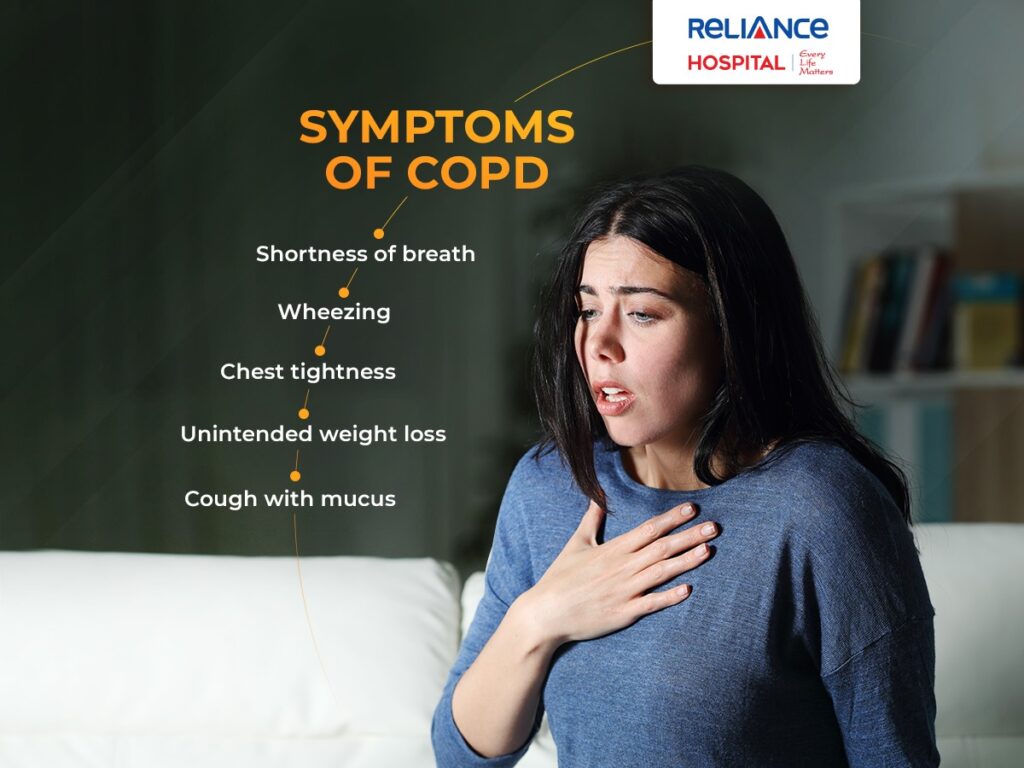Hidden Symptoms of COPD
Beyond the Cough: Exposing the COPD’s Hidden Symptoms
A chronic cough is a telltale indicator for many people with chronic obstructive pulmonary disease (COPD), as it is frequently connected with it. But there are other ways that COPD might present itself, and a cough isn’t usually the most obvious one. This can prevent early action, which is essential for effectively controlling the disease, and cause a delay in diagnosis.
Table of Contents

This blog post explores the subtle signs of COPD, enabling you to identify the illness beyond the cough and get help from a doctor as soon as possible.
Breathing difficulty (dyspnea)
Hidden Symptoms of COPD
One of the main symptoms of COPD is shortness of breath, which is frequently characterized as a sense of being out of breath or having trouble breathing. Usually, it gets worse when you strain yourself, such when you walk uphill or climb stairs. Shortness of breath, however, may only happen during vigorous exercise in the early stages. As the illness worsens, it may manifest itself even when you’re at rest, greatly affecting your day-to-day activities.
Weakness and Reduced Energy
Hidden Symptoms of COPD
Your lungs have a tougher time releasing carbon dioxide and taking in oxygen if you have COPD. exhaustion, a generalized sense of exhaustion, and a reduction in stamina can result from this oxygen shortage. You may notice that you become tired easily or that you need to take additional breaks during regular activities.
Regular Infections of the Chest
Hidden Symptoms of COPD
Bronchitis and pneumonia are two respiratory illnesses that people with COPD are more likely to have. These infections have the potential to exacerbate flare-ups and worsen pre-existing COPD symptoms, which can be extremely uncomfortable and lower your quality of life.
Ankle swelling (peripheral edema)
Hidden Symptoms of COPD
The strain on your lungs in severe stages of COPD might impair the effectiveness of your heart’s blood pumping mechanism. This may result in a buildup of fluid in the ankles and legs, which would enlarge them.
Losing Weight and Wasting Muscle
Hidden Symptoms of COPD
Breathing difficulties brought on by COPD can make ordinary chores more laborious. This may cause an unintentional reduction in appetite and calorie consumption, which could contribute to weight loss. To make more energy, the body may also begin to break down muscle tissue, which would further contribute to muscle atrophy.
Nail Shape Alterations (Finger Clubbing)
Hidden Symptoms of COPD
Finger clubbing, a condition where the tips of the fingers broaden and the nails round out, is occasionally brought on by COPD. Though uncommon and not unique to COPD, this symptom calls for a conversation with your physician.
The Value of Timely Diagnosis
Hidden Symptoms of COPD
To manage COPD and stop additional lung damage, an early diagnosis is essential. See your physician if you encounter any of the aforementioned symptoms, especially if they are ongoing or getting worse over time. To diagnose and ascertain the stage of COPD, they can do a physical examination, lung function tests, and chest X-rays.
Adapting to COPD Well
Hidden Symptoms of COPD
Although COPD is a chronic illness, there are strategies for managing it well and leading a happy life. Here are some pointers:
- Quitting smoking: is the single most essential thing you can do to slow down the progression of COPD if you smoke.
- Medication: Breathing difficulties, inflammation reduction, and airway relaxation are all made possible by inhalers and other drugs.
- Pulmonary Rehabilitation: To help you control your COPD symptoms and enhance your general health, this program combines education and exercise training.
- Vaccination: Getting vaccinated against pneumonia and the flu on a regular basis can help avoid respiratory infections that exacerbate COPD.
You may take charge of your health and lead a full life even with COPD if you are aware of its hidden symptoms and seek treatment as soon as possible. Recall that COPD is controllable; you can live a better quality of life and breathe easier with the right medication and lifestyle adjustments.


